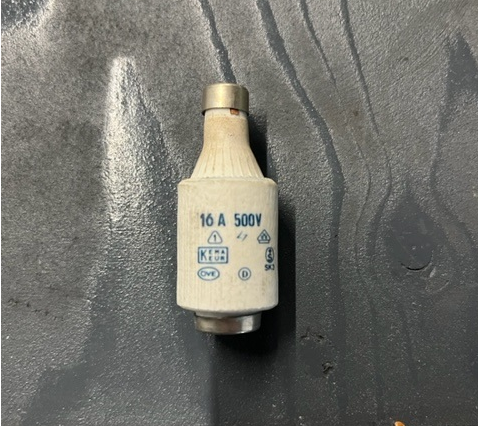This arrangement was at the intake position of a vehicle workshop with no upstream isolator. Change fuses at your peril!
Any one familiar with set-up, I remember something similar in my daughter's ancient apartment in Romania.


That is a blast from the past. East Germany was very similar too at one time. when a building supply was 3 phase at about 30 amps a phase from overheads on an H -pole . A steady hand is certainly needed when changing the bottle tops in the older style cabinets.
The local approach was to wear gloves of some kind - probably for flash injury as much as shock.
The fuses however are very good - with the right holder the diameter of the snout means you cannot put an oversize fuse in, and there were indicator models also available, with a spring and a little cap that dropped off if the fuse wire had broken showing which one to change..
The bullet shape means the non-rupturing breaking capacity of some of these is massive - from memory for incomer ones, figures like 50kA AC and 8KA DC, and means that questions of 16kA or 32KA PSSC would be utterly moot.
Actually in the east except perhaps in central Berlin there was no chance of that sort of current anyway, managing more than 200V on full load in some places would have been good !!
Mike
An old Siemens board - we had loads of them inside German & Italian machine tools control cabinets. The fuses are screw-in types which have a coloured coded 'dot' or cap in the front which denoted it's rating, and which also popped out when the fuse blew. Still quite a few about I'll bet. We had them inside Morando vertical boring machines and Erfurt steel bar cropping machines.
"coded 'dot' or cap in the front which denoted it's rating, and which also popped out when the fuse blew. "
Ah yes - those are the indicator models I was trying to describe, Some of the screw tops had a glas window so you could see that without opening anything.
Once you get used to them, they are quite a good system.
Mike
"coded 'dot' or cap in the front which denoted it's rating, and which also popped out when the fuse blew. "
Ah yes - those are the indicator models I was trying to describe, Some of the screw tops had a glas window so you could see that without opening anything.
Once you get used to them, they are quite a good system.
Mike
We're about to take you to the IET registration website. Don't worry though, you'll be sent straight back to the community after completing the registration.
Continue to the IET registration site